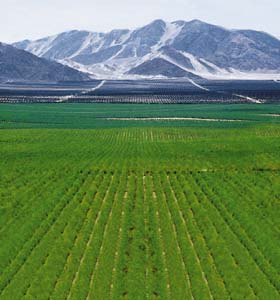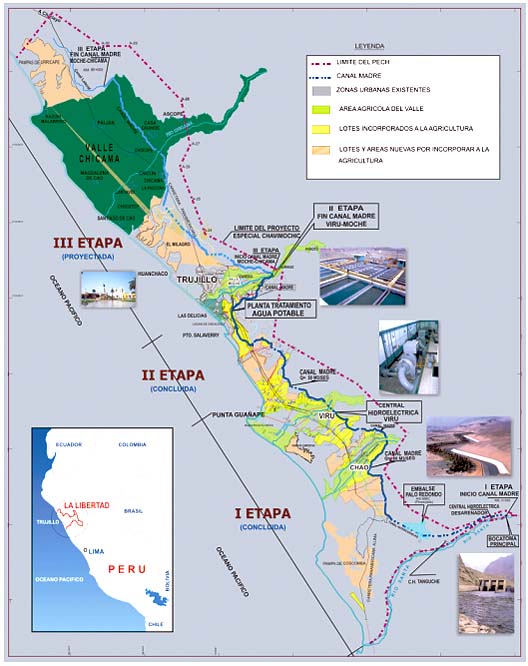Background
During the past century, various Peruvian Governments were concerned about the water deficit existing in many valleys in the Coastal Region of the country. Indeed the water deficit was, and is, the single most important factor hampering overall development. In general, most of the rivers coming down from the western side of the Andean Ranges carry enough surface water only from January to March. The rest of the year, from April to December, there is a water shortage, to serve agriculture, industry, manufacture and domestic uses.
Some 450 kilometres north of Lima along the Costal Region of Peru the Santa River, which marks the border between the Ancash and La Libertad Regions, discharges into the Pacific Ocean. The Santa River is one of the few perennial rivers discharging from the mountains. Upstream, one intake structure diverts part of the river flow northwards into La Libertad Region. The diverted flow is used by the Chavimochic project covering several valleys. These valleys, narrow upstream and wider downstream, all have a seasonal river which command land for irrigation although at times it floods.

Current view of the new lands
in the Chavimochic project.
The Chavimochic Multi-purpose Project
Specifically regarding the Chavimochic project, the acronym is formed by the first letters of the names of the valleys where the water is used, namely, Chao, Viru, Moche and Chicama, all of which are located on the right hand side of the Santa River. There were thousands of hectares between successive valleys lying idle due to lack of water. These lands are the so called inter-valleys and are at a higher topographical elevation than the valley itself, therefore difficult, if not impossible, to irrigate by gravity from their respective seasonal rivers. These lands were true deserts, mostly eolic sands or soils with no structure and with very high infiltration rates and high temperatures during the summer. Indeed, a challenge for development, along with an eagerness to expand the agricultural frontier. Photo shows the current view of the new lands.
The Chavimochic multipurpose project's ultimate aim is to bring 70 000 hectares of desert lands (inter-valleys) under irrigation and to improve the irrigation of more than 74 000 hectares of old lands located in the valleys. The water from the Santa River was diverted northwards by a main canal of about 83.4 kilometres. In addition, it will generate 68 MW of electricity though 3 hydropower stations; and will supply 1 000 litres/sec of potable water to the City of Trujillo. Preliminary field work for the Chavimochic project started in 1960, the construction of the hydraulic infrastructure started in 1986 and was completed in 1990. It was only in 1994 that the process of territorial occupation really started.
The Project is applying conventional technologies to conquer the deserts between the inter-valleys and introducing innovations and creating synergies leading to the production of high economic-return crops. All this makes Chavimochic a most outstanding project. The Project is already meeting the challenge of water professionals regarding water use efficiency, high return crops, expansion of the agricultural frontier, integral and biological pest control, organic fertilization, employment generating enterprises, and farmers paying the right water tariffs.
Land development
The inter-valley areas were public lands belonging to the country. The area was sold by the government through a sui generis international bidding process. This land selling process started with the basic concept of land property - land titles - and fully adhered to and respected the Peruvian judicial establishment. The land transfer to the private sector was carried out in lots of varying sizes, from 50 to more than 1 000 hectares. The single most important factor determining the winners was the commitment to invest the most in land development and in the shortest possible time. In addition, the winners were those paying higher prices and within the shortest possible time. These commitments were fully supported by a financial guarantee, so that the Government could repossess the land in case of failure to fulfil the agreed conditions.
Once the winners of the bidding process took possession of the land, they fenced it with trees, stakes or shrubs. Then, a rough land grading was carried out, simultaneously building the irrigation water intake to allow the diversion of water from the Main Canal built by the Government of Peru (GOP). At the same time, the owners installed the head units (measuring, filtration, fertigation, chemigation) for the localized irrigation systems along with the desilting basin for the final evacuation of suspended solids removed from the irrigation water and the main piping system for the distribution of water. Farmers in the inter-valley areas use different types of fully automatic localised irrigation system (drippers, tapes, etc.) with end-of-line self-flushers to allow continuous removal of fine sediments. Sand, screen and ring filters are also used by many owners in Chavimochic to capture and remove suspended solids in the incoming water.
Organic matter was abundantly applied, up to 100 metric tonnes per hectare, in order to improve the physical and chemical characteristics of the soil. Soil moisture retention was therefore increased as well as plant nutrient availability. It must be stressed that fertigation and chemigation is a common practice in the development of these desert lands.
Crops and water availability
The main crops in these lands are white asparagus, red pepper or paprika, avocado, artichoke, bonete pepper, onions, beans and many others, including sugar cane. One important asset that the region counts on is the absence of low temperatures, indeed the average yearly temperature is 19.1°C. Farming is therefore allowed throughout the year. In addition, water availability is ensured at all times from the main canal which runs northwards at a topographical position of some 50 metres above the lands providing position-hydraulic permanent head. There is no need for pumping, the water is already pressurized.

Map of Chavimochic.
Water tariffs
Farmers pay about US$0.025 per cubic metre for the water service. Water delivery is measured by flow metres, similar to those used for domestic purposes. The desert lands were sold with the understanding that the Government ensures the yearly allocation of 10 000 cubic metres per hectare. The Water User Association (WUA) receives a detailed listing of the amount of water used by each farmer. The WUA collects the payments for the water service and farmers have two months to pay. Afterwards, the WUA delivers to the Board of the Multipurpose Chavimochic Project the share of the total tariff corresponding to: (i) payback of the investment; and (ii) the cost of the operation and maintenance of the hydraulic infrastructure, taking into consideration the volume of water used.
Rate of land transfer and exports
So far, close to 27 000 hectares have been sold through the international competitive process. Another 5 100 hectares have gone through direct sales and 1 000 hectares went to the San Jose farmers community, bringing the total land assignment process to a net area of 32 990 hectares. According to the Representative of Owners of the new lands, currently there are more than 15 000 hectares under production, and they expect to export about US$180 million in 2005. The potential is clearly spectacular, with an opportunity for the creation of jobs for more than 30 000 families in direct employment, and to export about US$1 400 million in the immediate future.
Consequent to the above, from 1995 to 2005 so far 11 export companies have been involved in the Project. The total value of exports of agricultural production has reached more than US$600 million; increasing from US$18.8 million in 1995 to US$151.1 million in 2004. The projected export for 2005 stands now at US$180 million. Farmers continue in the search for new international market openings, with emphasis on European and other markets. The Peruvian market is small for this type of produce and still shows low interest. The produce is however highly regarded in foreign lands for its high quality.
Further development of the Region
In the meantime development continues. Livestock for milk production and sheep fore meat is spreading quite fast. Poultry production has increased tremendously. Even the famous Peruvian horses are bred in some farms. The availability of crop residues has made all these activities possible, including the exploitation of compost and organic manure, generating a close circle for sustainable crop and animal production.
This type of agro-industrial exporting and competitive development within the current world globalization is attracting many others and is spreading to other irrigation projects in the Costal and in the Sierra (Mountainous) Regions of the country. Even small farmers with 3 hectares or less are searching for some form of associations in order to apply the Chavimochic development model.
Some individual examples may be cited from the old lands in the valleys of Chao and Viru. Associated farmers, with little or no Government assistance are using shallow groundwater with equipment for drip irrigation. In addition, they also have purchased small gasoline internal combustion engines to drive pumps. Currently, the Government is investing in the electrification infrastructure to promote the adoption of pressurized irrigation systems, such as the ones in the new lands of Chavimochic.
Simultaneously, the areas of the old lands, are trying to use irrigation water more efficiently and to improve irrigation distribution and scheduling. In other words, farmers are encouraged to request the amount of water that the crop really needs, therefore paying for service corresponding to the right volume of water, and at the same time, ensuring that water will be delivered on time and for the time required according to the flow. Chavimochic is using the software IRRIGATION DISTRIBUTION SYSTEM (IDIS) developed within the framework of a Letter of Agreement between the Food and Agriculture Organization of the United Nations (FAO) and Chavimochic in the 1990s. The software is proving very valuable for the purpose.
The future
The Government investment in Chavimochic has been very high in the construction of hydraulic works. These have made possible the availability of water to the desert lands and at the same time, agricultural entrepreneurs are positively meeting the challenge, with their own investments, with high technological packages and with an overall focus on the environment and a high sense of responsibility.
Both, the Government and the agricultural entrepreneurs have a pending agenda. In order to ensure the sustainability of the Chavimochic project both partners must seriously consider the need to build additional major infrastructure in view of occasional and long term changes, such as the effects of global warming and diminishing flows of the Santa River. For its part the Government must undertake the responsibility: (i) to ensure the basin stabilization, adapting to expected conditions as a result of global climatic changes, and (ii) to carry the Chavimochic to its completion since it is currently in its second stage. Farmers must pledge to participate in the maintenance of the project and creatively adapt themselves to the upcoming climatic conditions, phytosanitary environment, and to take full advantage of the international agricultural marketing opportunities, among others. The Chavimochic project is the dream come true for many agricultural specialists and other professionals who envision a better future for mankind.
For further details
contact Fernando Chanduvi at: [email protected]